Engineering Risk Management: Case Studies of Man-Made Disasters Report
VerifiedAdded on 2021/06/18
|23
|4966
|22
Report
AI Summary
This report delves into the critical field of engineering risk management, focusing on the analysis of man-made disasters to understand the importance of effective risk assessment and mitigation strategies. The report presents three detailed case studies: the Bhopal Gas Leakage, the Texas City Refinery Explosion, and the Deepwater Horizon Oil Disaster. Each case study examines the causes of the disaster, the failures in risk management, and the potential strategies that could have been implemented to prevent or mitigate the incidents. The report explores the key steps in risk management, including risk identification, assessment, and control, providing insights into the importance of proactive measures, communication plans, and adherence to safety standards in the chemical and oil industries. The analysis highlights the severe consequences of inadequate risk management, including loss of life, environmental damage, and economic losses, emphasizing the need for robust safety protocols and continuous improvement in risk management practices.
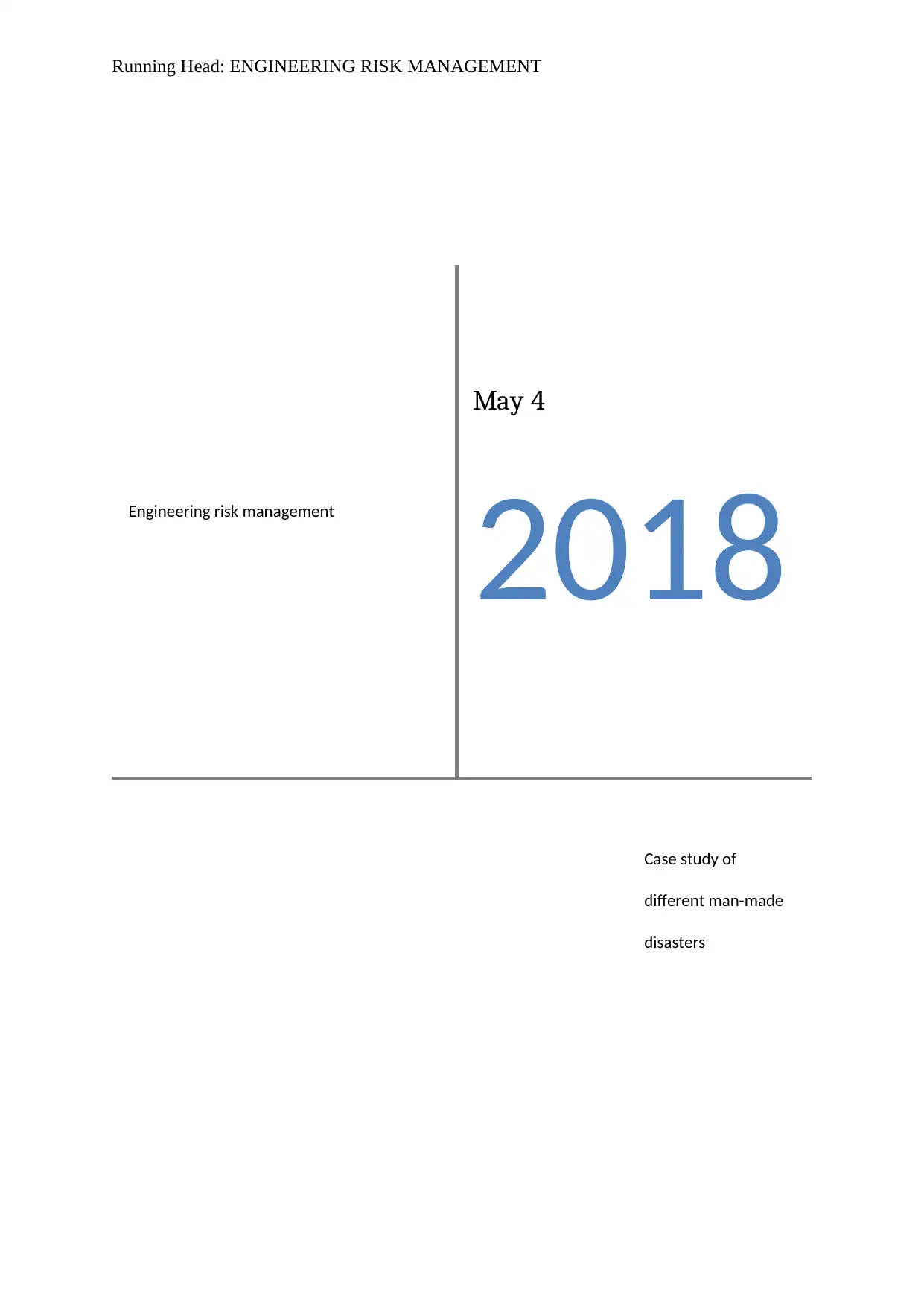
Running Head: ENGINEERING RISK MANAGEMENT
Engineering risk management
May 4
2018
Case study of
different man-made
disasters
Engineering risk management
May 4
2018
Case study of
different man-made
disasters
Paraphrase This Document
Need a fresh take? Get an instant paraphrase of this document with our AI Paraphraser
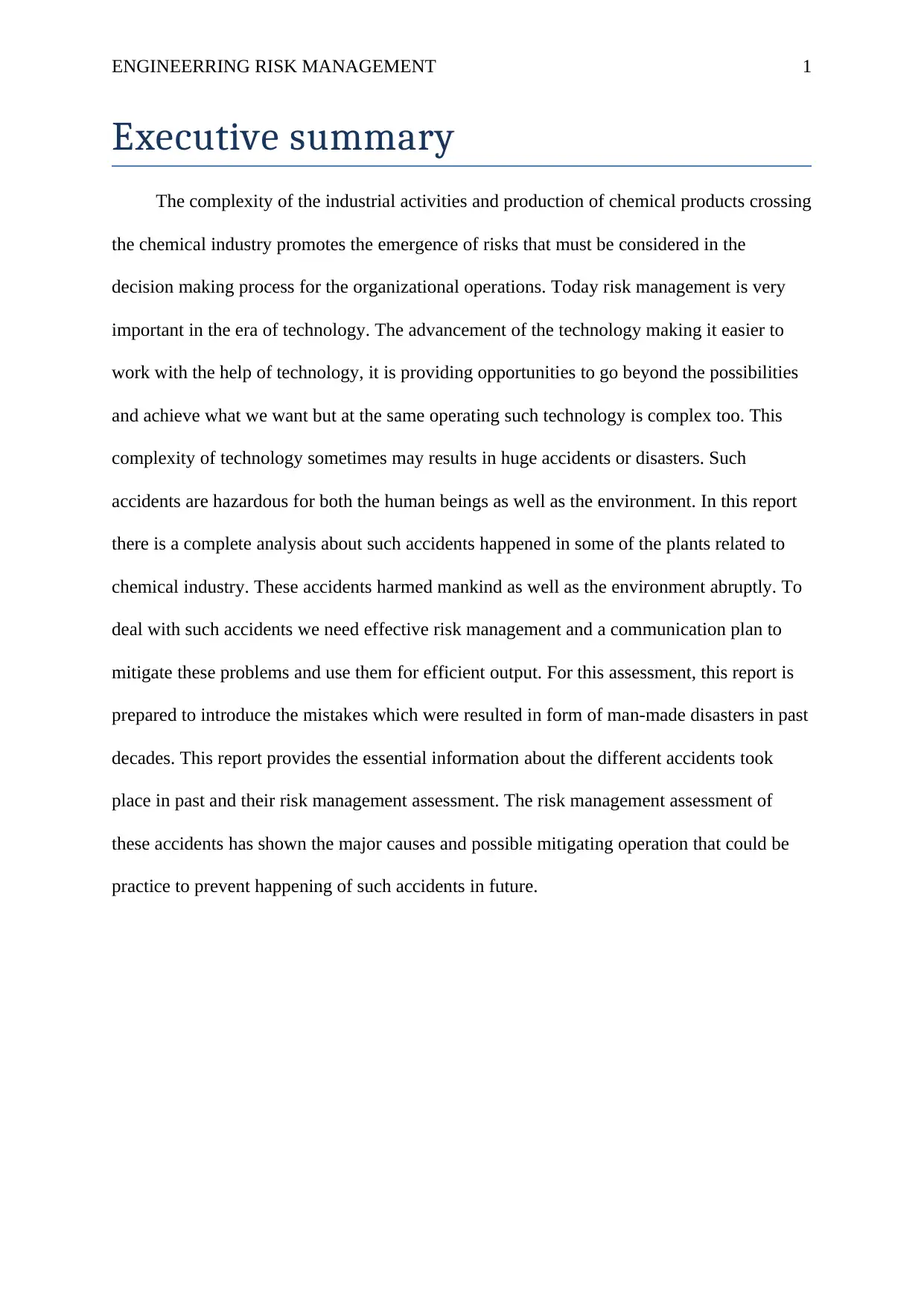
ENGINEERRING RISK MANAGEMENT 1
Executive summary
The complexity of the industrial activities and production of chemical products crossing
the chemical industry promotes the emergence of risks that must be considered in the
decision making process for the organizational operations. Today risk management is very
important in the era of technology. The advancement of the technology making it easier to
work with the help of technology, it is providing opportunities to go beyond the possibilities
and achieve what we want but at the same operating such technology is complex too. This
complexity of technology sometimes may results in huge accidents or disasters. Such
accidents are hazardous for both the human beings as well as the environment. In this report
there is a complete analysis about such accidents happened in some of the plants related to
chemical industry. These accidents harmed mankind as well as the environment abruptly. To
deal with such accidents we need effective risk management and a communication plan to
mitigate these problems and use them for efficient output. For this assessment, this report is
prepared to introduce the mistakes which were resulted in form of man-made disasters in past
decades. This report provides the essential information about the different accidents took
place in past and their risk management assessment. The risk management assessment of
these accidents has shown the major causes and possible mitigating operation that could be
practice to prevent happening of such accidents in future.
Executive summary
The complexity of the industrial activities and production of chemical products crossing
the chemical industry promotes the emergence of risks that must be considered in the
decision making process for the organizational operations. Today risk management is very
important in the era of technology. The advancement of the technology making it easier to
work with the help of technology, it is providing opportunities to go beyond the possibilities
and achieve what we want but at the same operating such technology is complex too. This
complexity of technology sometimes may results in huge accidents or disasters. Such
accidents are hazardous for both the human beings as well as the environment. In this report
there is a complete analysis about such accidents happened in some of the plants related to
chemical industry. These accidents harmed mankind as well as the environment abruptly. To
deal with such accidents we need effective risk management and a communication plan to
mitigate these problems and use them for efficient output. For this assessment, this report is
prepared to introduce the mistakes which were resulted in form of man-made disasters in past
decades. This report provides the essential information about the different accidents took
place in past and their risk management assessment. The risk management assessment of
these accidents has shown the major causes and possible mitigating operation that could be
practice to prevent happening of such accidents in future.
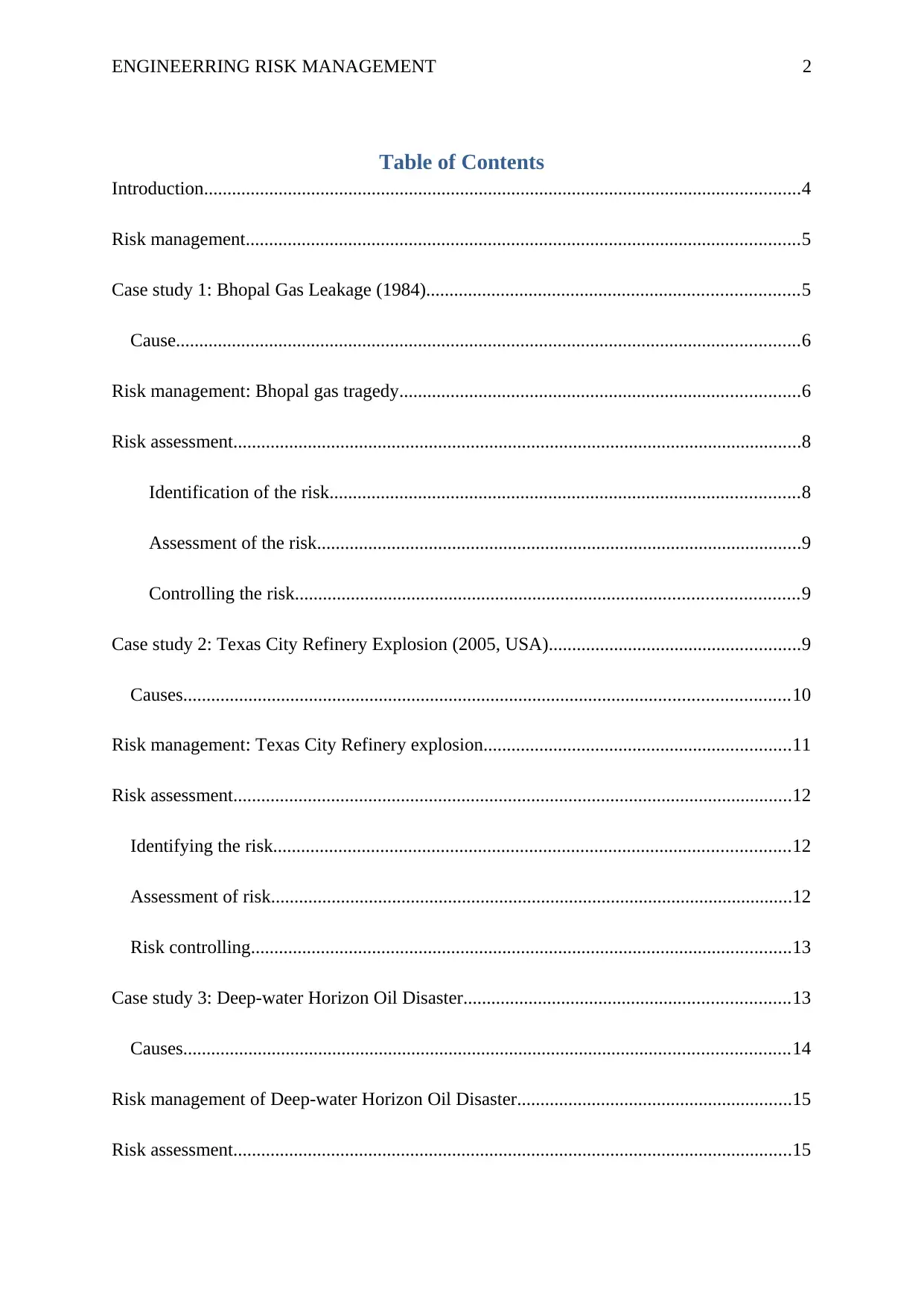
ENGINEERRING RISK MANAGEMENT 2
Table of Contents
Introduction................................................................................................................................4
Risk management.......................................................................................................................5
Case study 1: Bhopal Gas Leakage (1984)................................................................................5
Cause......................................................................................................................................6
Risk management: Bhopal gas tragedy......................................................................................6
Risk assessment..........................................................................................................................8
Identification of the risk.....................................................................................................8
Assessment of the risk........................................................................................................9
Controlling the risk............................................................................................................9
Case study 2: Texas City Refinery Explosion (2005, USA)......................................................9
Causes..................................................................................................................................10
Risk management: Texas City Refinery explosion..................................................................11
Risk assessment........................................................................................................................12
Identifying the risk...............................................................................................................12
Assessment of risk................................................................................................................12
Risk controlling....................................................................................................................13
Case study 3: Deep-water Horizon Oil Disaster......................................................................13
Causes..................................................................................................................................14
Risk management of Deep-water Horizon Oil Disaster...........................................................15
Risk assessment........................................................................................................................15
Table of Contents
Introduction................................................................................................................................4
Risk management.......................................................................................................................5
Case study 1: Bhopal Gas Leakage (1984)................................................................................5
Cause......................................................................................................................................6
Risk management: Bhopal gas tragedy......................................................................................6
Risk assessment..........................................................................................................................8
Identification of the risk.....................................................................................................8
Assessment of the risk........................................................................................................9
Controlling the risk............................................................................................................9
Case study 2: Texas City Refinery Explosion (2005, USA)......................................................9
Causes..................................................................................................................................10
Risk management: Texas City Refinery explosion..................................................................11
Risk assessment........................................................................................................................12
Identifying the risk...............................................................................................................12
Assessment of risk................................................................................................................12
Risk controlling....................................................................................................................13
Case study 3: Deep-water Horizon Oil Disaster......................................................................13
Causes..................................................................................................................................14
Risk management of Deep-water Horizon Oil Disaster...........................................................15
Risk assessment........................................................................................................................15
⊘ This is a preview!⊘
Do you want full access?
Subscribe today to unlock all pages.

Trusted by 1+ million students worldwide
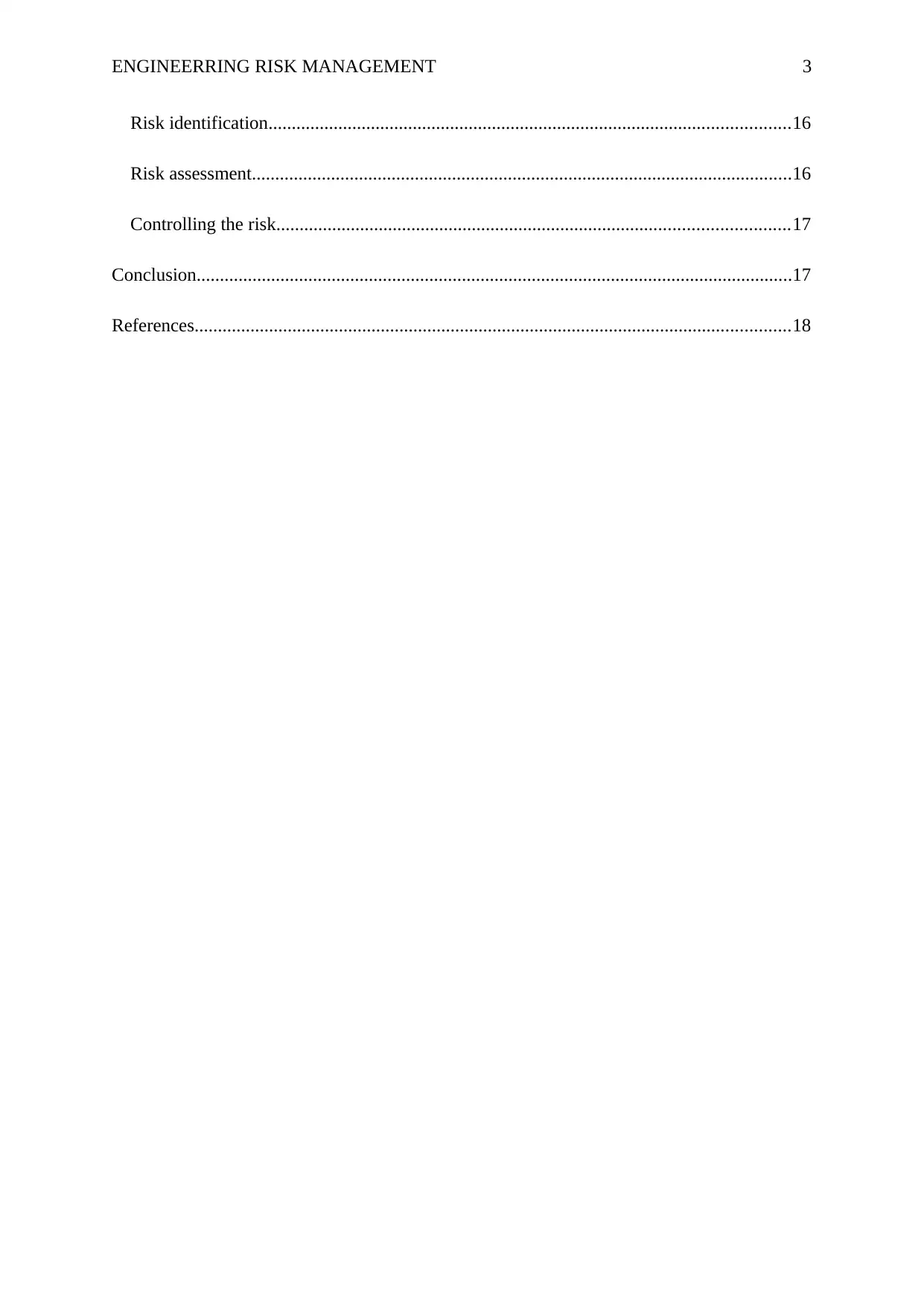
ENGINEERRING RISK MANAGEMENT 3
Risk identification................................................................................................................16
Risk assessment....................................................................................................................16
Controlling the risk..............................................................................................................17
Conclusion................................................................................................................................17
References................................................................................................................................18
Risk identification................................................................................................................16
Risk assessment....................................................................................................................16
Controlling the risk..............................................................................................................17
Conclusion................................................................................................................................17
References................................................................................................................................18
Paraphrase This Document
Need a fresh take? Get an instant paraphrase of this document with our AI Paraphraser
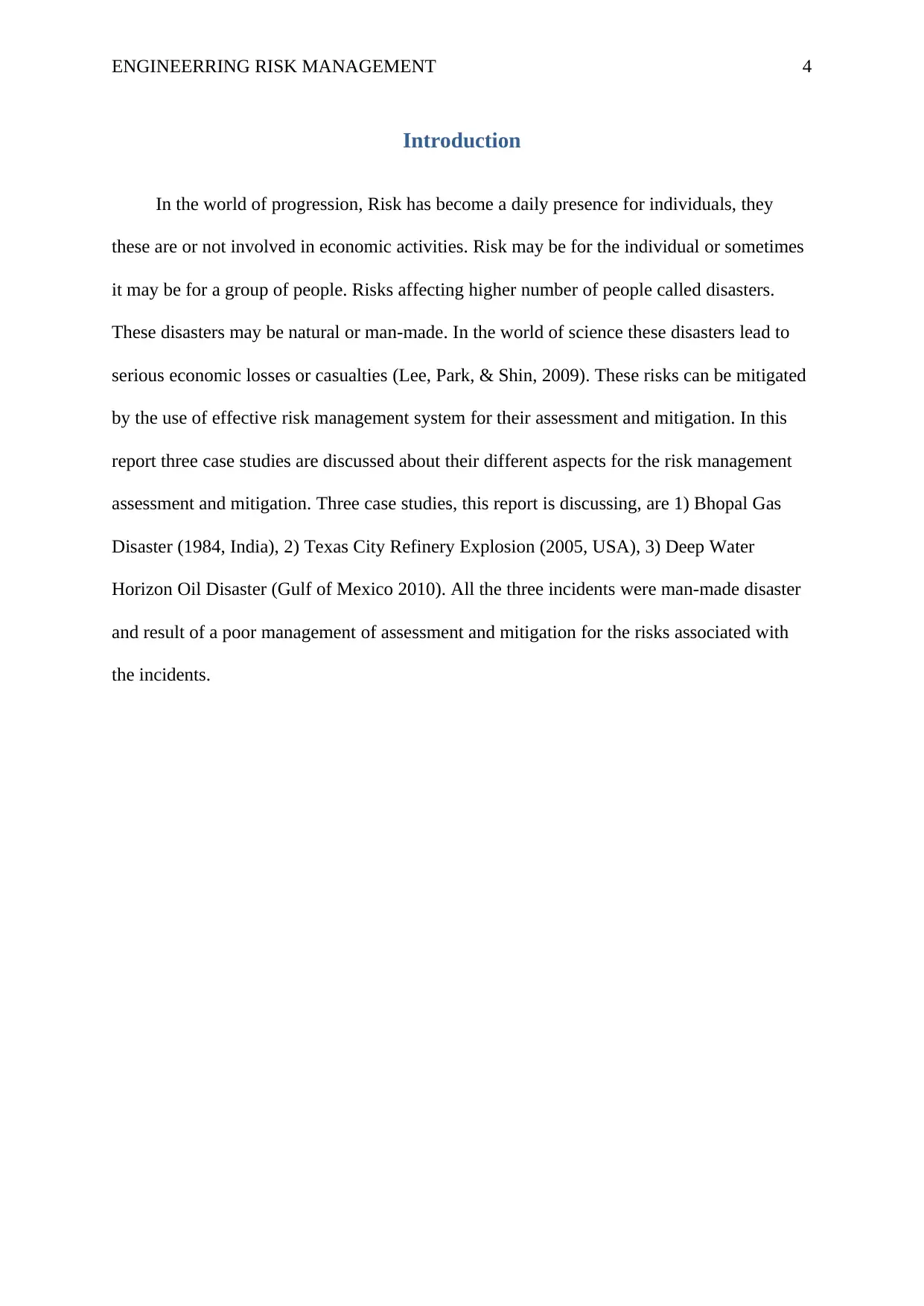
ENGINEERRING RISK MANAGEMENT 4
Introduction
In the world of progression, Risk has become a daily presence for individuals, they
these are or not involved in economic activities. Risk may be for the individual or sometimes
it may be for a group of people. Risks affecting higher number of people called disasters.
These disasters may be natural or man-made. In the world of science these disasters lead to
serious economic losses or casualties (Lee, Park, & Shin, 2009). These risks can be mitigated
by the use of effective risk management system for their assessment and mitigation. In this
report three case studies are discussed about their different aspects for the risk management
assessment and mitigation. Three case studies, this report is discussing, are 1) Bhopal Gas
Disaster (1984, India), 2) Texas City Refinery Explosion (2005, USA), 3) Deep Water
Horizon Oil Disaster (Gulf of Mexico 2010). All the three incidents were man-made disaster
and result of a poor management of assessment and mitigation for the risks associated with
the incidents.
Introduction
In the world of progression, Risk has become a daily presence for individuals, they
these are or not involved in economic activities. Risk may be for the individual or sometimes
it may be for a group of people. Risks affecting higher number of people called disasters.
These disasters may be natural or man-made. In the world of science these disasters lead to
serious economic losses or casualties (Lee, Park, & Shin, 2009). These risks can be mitigated
by the use of effective risk management system for their assessment and mitigation. In this
report three case studies are discussed about their different aspects for the risk management
assessment and mitigation. Three case studies, this report is discussing, are 1) Bhopal Gas
Disaster (1984, India), 2) Texas City Refinery Explosion (2005, USA), 3) Deep Water
Horizon Oil Disaster (Gulf of Mexico 2010). All the three incidents were man-made disaster
and result of a poor management of assessment and mitigation for the risks associated with
the incidents.
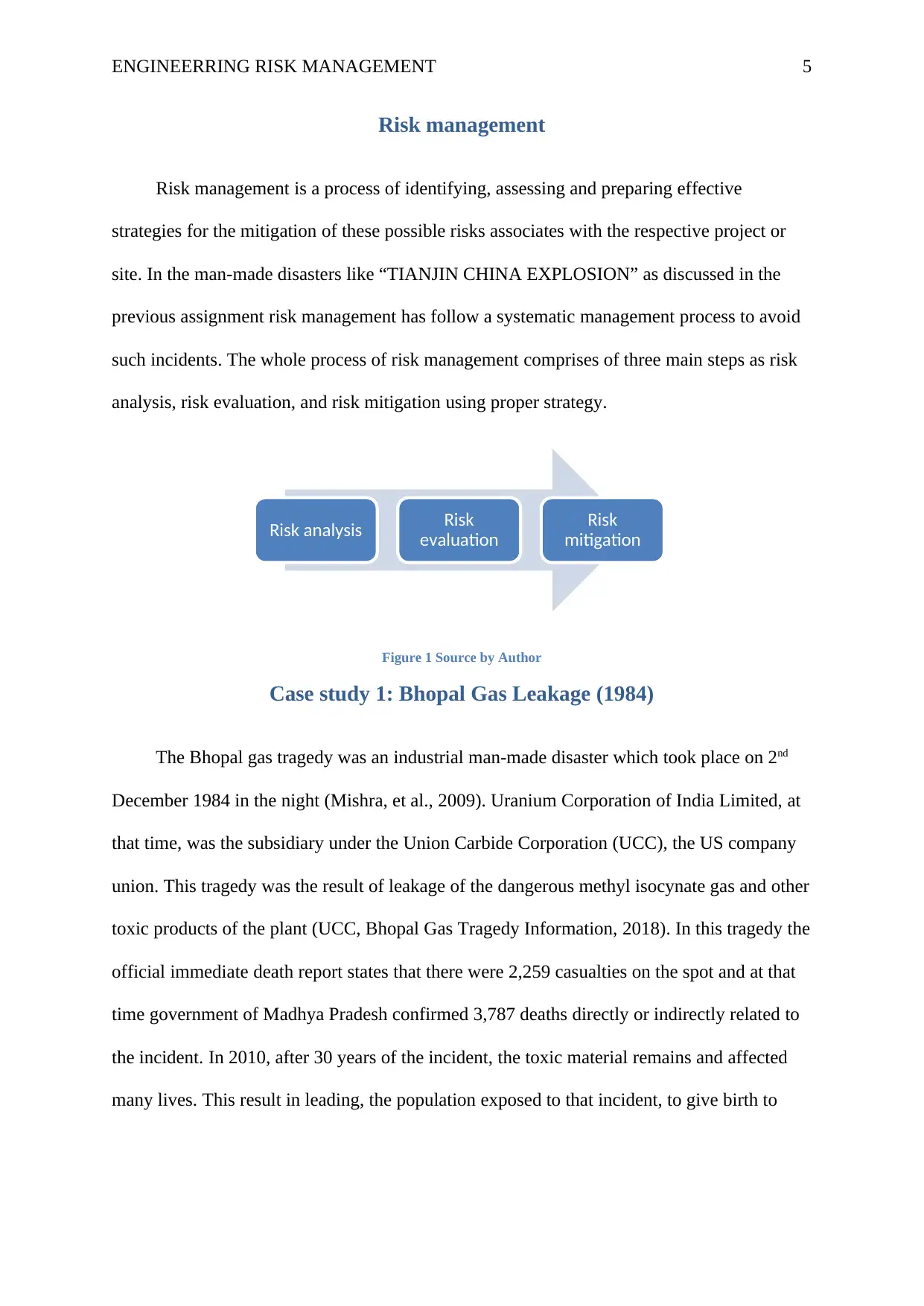
ENGINEERRING RISK MANAGEMENT 5
Risk management
Risk management is a process of identifying, assessing and preparing effective
strategies for the mitigation of these possible risks associates with the respective project or
site. In the man-made disasters like “TIANJIN CHINA EXPLOSION” as discussed in the
previous assignment risk management has follow a systematic management process to avoid
such incidents. The whole process of risk management comprises of three main steps as risk
analysis, risk evaluation, and risk mitigation using proper strategy.
Figure 1 Source by Author
Case study 1: Bhopal Gas Leakage (1984)
The Bhopal gas tragedy was an industrial man-made disaster which took place on 2nd
December 1984 in the night (Mishra, et al., 2009). Uranium Corporation of India Limited, at
that time, was the subsidiary under the Union Carbide Corporation (UCC), the US company
union. This tragedy was the result of leakage of the dangerous methyl isocynate gas and other
toxic products of the plant (UCC, Bhopal Gas Tragedy Information, 2018). In this tragedy the
official immediate death report states that there were 2,259 casualties on the spot and at that
time government of Madhya Pradesh confirmed 3,787 deaths directly or indirectly related to
the incident. In 2010, after 30 years of the incident, the toxic material remains and affected
many lives. This result in leading, the population exposed to that incident, to give birth to
Risk analysis Risk
evaluation
Risk
mitigation
Risk management
Risk management is a process of identifying, assessing and preparing effective
strategies for the mitigation of these possible risks associates with the respective project or
site. In the man-made disasters like “TIANJIN CHINA EXPLOSION” as discussed in the
previous assignment risk management has follow a systematic management process to avoid
such incidents. The whole process of risk management comprises of three main steps as risk
analysis, risk evaluation, and risk mitigation using proper strategy.
Figure 1 Source by Author
Case study 1: Bhopal Gas Leakage (1984)
The Bhopal gas tragedy was an industrial man-made disaster which took place on 2nd
December 1984 in the night (Mishra, et al., 2009). Uranium Corporation of India Limited, at
that time, was the subsidiary under the Union Carbide Corporation (UCC), the US company
union. This tragedy was the result of leakage of the dangerous methyl isocynate gas and other
toxic products of the plant (UCC, Bhopal Gas Tragedy Information, 2018). In this tragedy the
official immediate death report states that there were 2,259 casualties on the spot and at that
time government of Madhya Pradesh confirmed 3,787 deaths directly or indirectly related to
the incident. In 2010, after 30 years of the incident, the toxic material remains and affected
many lives. This result in leading, the population exposed to that incident, to give birth to
Risk analysis Risk
evaluation
Risk
mitigation
⊘ This is a preview!⊘
Do you want full access?
Subscribe today to unlock all pages.

Trusted by 1+ million students worldwide
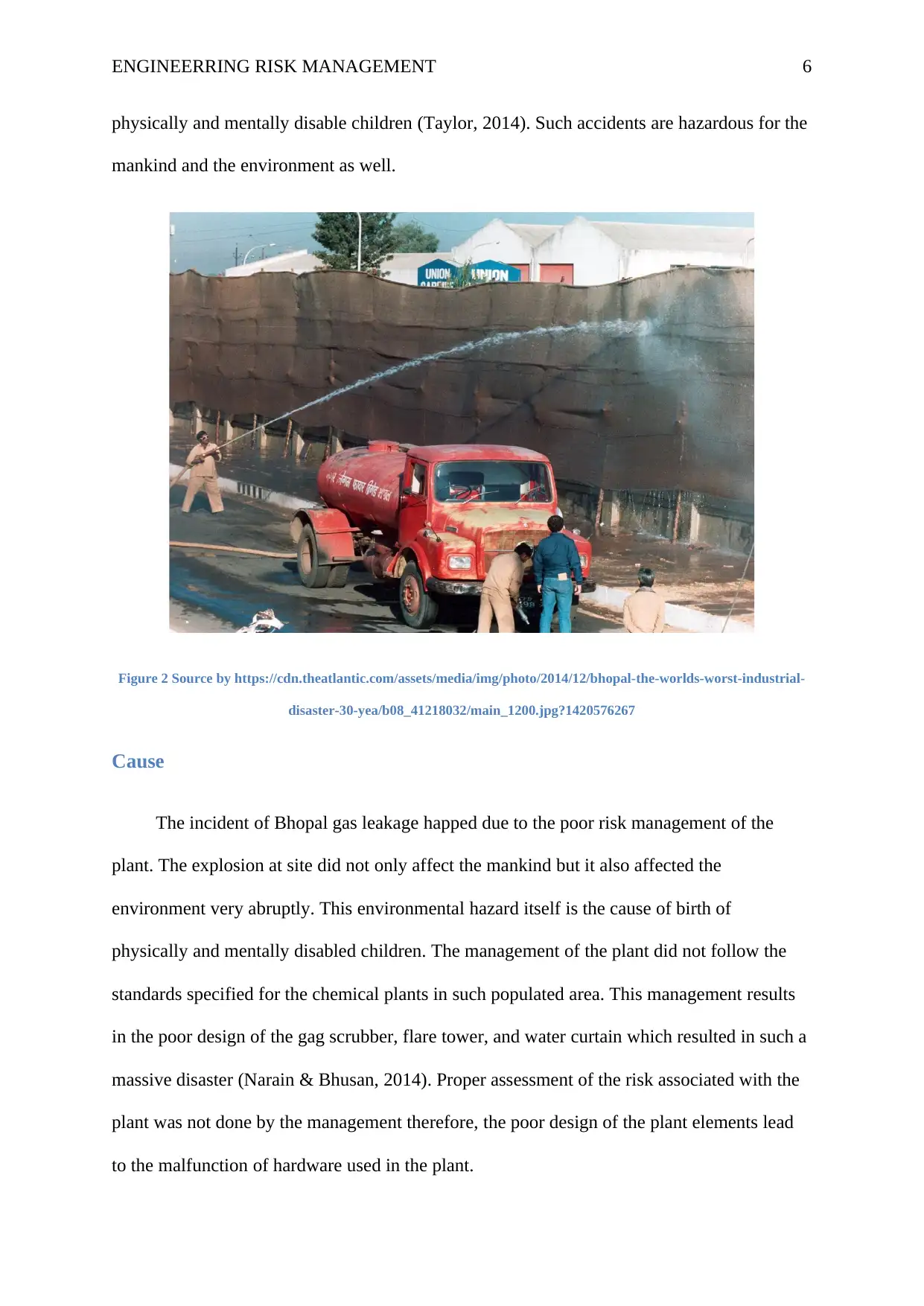
ENGINEERRING RISK MANAGEMENT 6
physically and mentally disable children (Taylor, 2014). Such accidents are hazardous for the
mankind and the environment as well.
Figure 2 Source by https://cdn.theatlantic.com/assets/media/img/photo/2014/12/bhopal-the-worlds-worst-industrial-
disaster-30-yea/b08_41218032/main_1200.jpg?1420576267
Cause
The incident of Bhopal gas leakage happed due to the poor risk management of the
plant. The explosion at site did not only affect the mankind but it also affected the
environment very abruptly. This environmental hazard itself is the cause of birth of
physically and mentally disabled children. The management of the plant did not follow the
standards specified for the chemical plants in such populated area. This management results
in the poor design of the gag scrubber, flare tower, and water curtain which resulted in such a
massive disaster (Narain & Bhusan, 2014). Proper assessment of the risk associated with the
plant was not done by the management therefore, the poor design of the plant elements lead
to the malfunction of hardware used in the plant.
physically and mentally disable children (Taylor, 2014). Such accidents are hazardous for the
mankind and the environment as well.
Figure 2 Source by https://cdn.theatlantic.com/assets/media/img/photo/2014/12/bhopal-the-worlds-worst-industrial-
disaster-30-yea/b08_41218032/main_1200.jpg?1420576267
Cause
The incident of Bhopal gas leakage happed due to the poor risk management of the
plant. The explosion at site did not only affect the mankind but it also affected the
environment very abruptly. This environmental hazard itself is the cause of birth of
physically and mentally disabled children. The management of the plant did not follow the
standards specified for the chemical plants in such populated area. This management results
in the poor design of the gag scrubber, flare tower, and water curtain which resulted in such a
massive disaster (Narain & Bhusan, 2014). Proper assessment of the risk associated with the
plant was not done by the management therefore, the poor design of the plant elements lead
to the malfunction of hardware used in the plant.
Paraphrase This Document
Need a fresh take? Get an instant paraphrase of this document with our AI Paraphraser
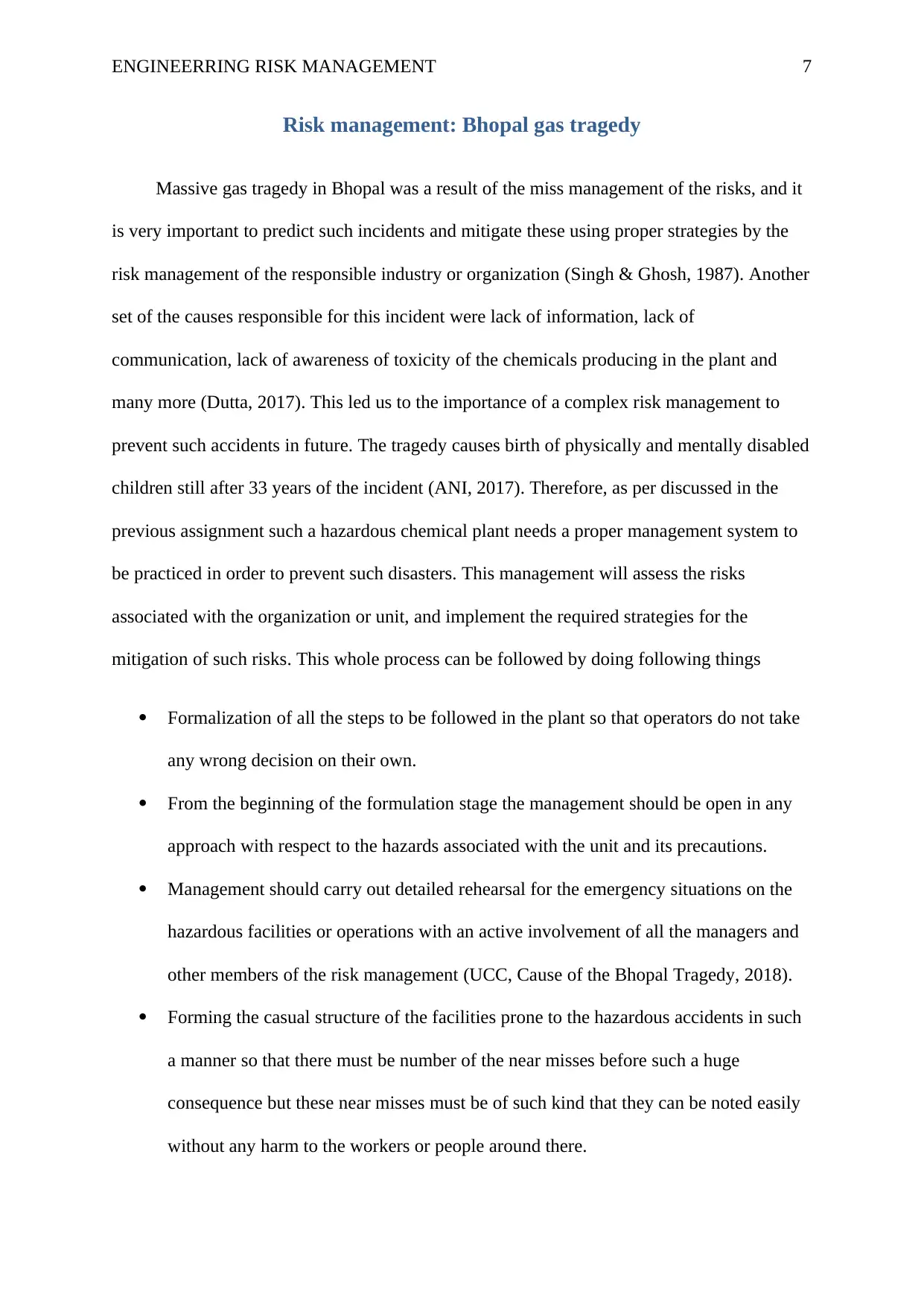
ENGINEERRING RISK MANAGEMENT 7
Risk management: Bhopal gas tragedy
Massive gas tragedy in Bhopal was a result of the miss management of the risks, and it
is very important to predict such incidents and mitigate these using proper strategies by the
risk management of the responsible industry or organization (Singh & Ghosh, 1987). Another
set of the causes responsible for this incident were lack of information, lack of
communication, lack of awareness of toxicity of the chemicals producing in the plant and
many more (Dutta, 2017). This led us to the importance of a complex risk management to
prevent such accidents in future. The tragedy causes birth of physically and mentally disabled
children still after 33 years of the incident (ANI, 2017). Therefore, as per discussed in the
previous assignment such a hazardous chemical plant needs a proper management system to
be practiced in order to prevent such disasters. This management will assess the risks
associated with the organization or unit, and implement the required strategies for the
mitigation of such risks. This whole process can be followed by doing following things
Formalization of all the steps to be followed in the plant so that operators do not take
any wrong decision on their own.
From the beginning of the formulation stage the management should be open in any
approach with respect to the hazards associated with the unit and its precautions.
Management should carry out detailed rehearsal for the emergency situations on the
hazardous facilities or operations with an active involvement of all the managers and
other members of the risk management (UCC, Cause of the Bhopal Tragedy, 2018).
Forming the casual structure of the facilities prone to the hazardous accidents in such
a manner so that there must be number of the near misses before such a huge
consequence but these near misses must be of such kind that they can be noted easily
without any harm to the workers or people around there.
Risk management: Bhopal gas tragedy
Massive gas tragedy in Bhopal was a result of the miss management of the risks, and it
is very important to predict such incidents and mitigate these using proper strategies by the
risk management of the responsible industry or organization (Singh & Ghosh, 1987). Another
set of the causes responsible for this incident were lack of information, lack of
communication, lack of awareness of toxicity of the chemicals producing in the plant and
many more (Dutta, 2017). This led us to the importance of a complex risk management to
prevent such accidents in future. The tragedy causes birth of physically and mentally disabled
children still after 33 years of the incident (ANI, 2017). Therefore, as per discussed in the
previous assignment such a hazardous chemical plant needs a proper management system to
be practiced in order to prevent such disasters. This management will assess the risks
associated with the organization or unit, and implement the required strategies for the
mitigation of such risks. This whole process can be followed by doing following things
Formalization of all the steps to be followed in the plant so that operators do not take
any wrong decision on their own.
From the beginning of the formulation stage the management should be open in any
approach with respect to the hazards associated with the unit and its precautions.
Management should carry out detailed rehearsal for the emergency situations on the
hazardous facilities or operations with an active involvement of all the managers and
other members of the risk management (UCC, Cause of the Bhopal Tragedy, 2018).
Forming the casual structure of the facilities prone to the hazardous accidents in such
a manner so that there must be number of the near misses before such a huge
consequence but these near misses must be of such kind that they can be noted easily
without any harm to the workers or people around there.
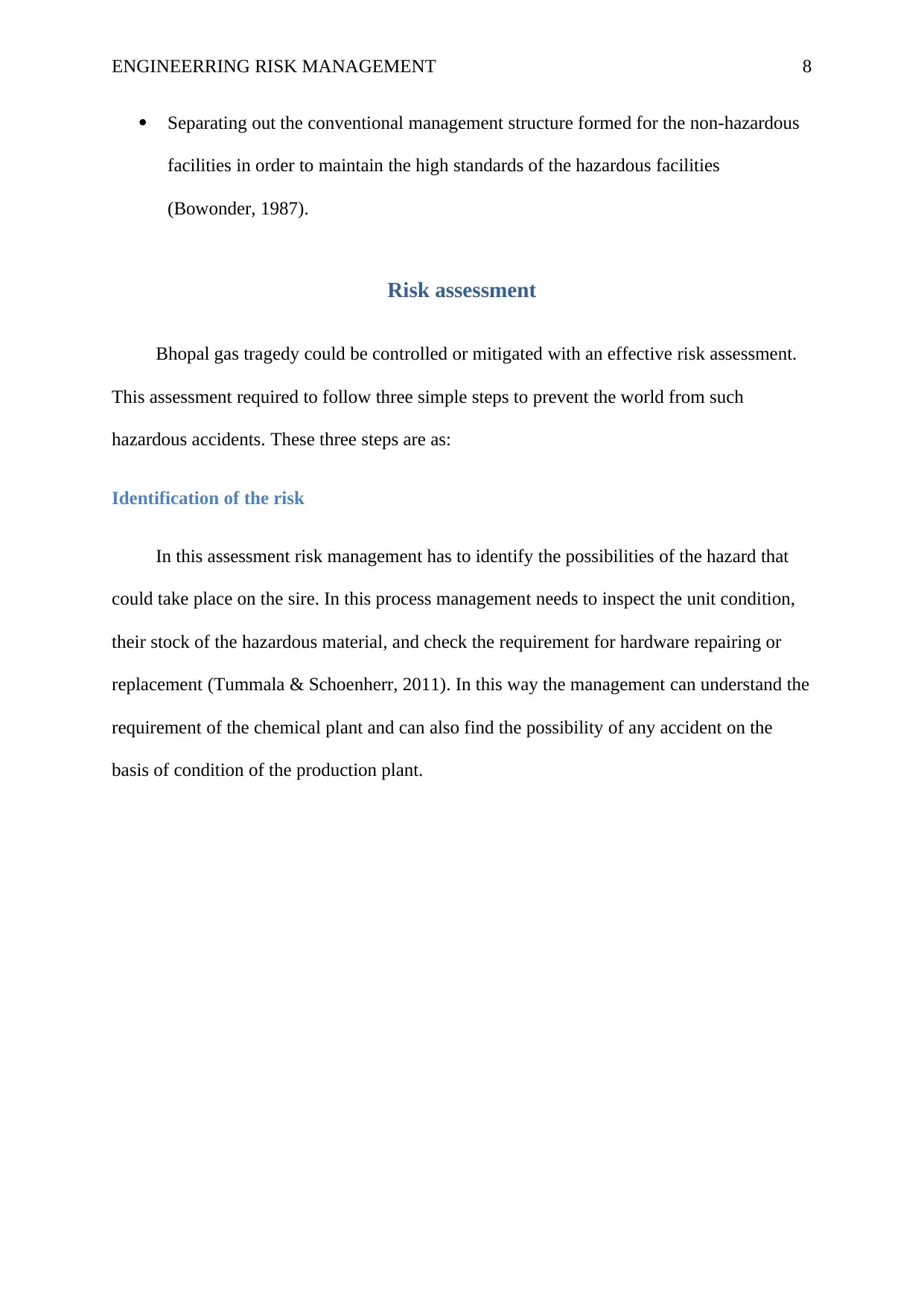
ENGINEERRING RISK MANAGEMENT 8
Separating out the conventional management structure formed for the non-hazardous
facilities in order to maintain the high standards of the hazardous facilities
(Bowonder, 1987).
Risk assessment
Bhopal gas tragedy could be controlled or mitigated with an effective risk assessment.
This assessment required to follow three simple steps to prevent the world from such
hazardous accidents. These three steps are as:
Identification of the risk
In this assessment risk management has to identify the possibilities of the hazard that
could take place on the sire. In this process management needs to inspect the unit condition,
their stock of the hazardous material, and check the requirement for hardware repairing or
replacement (Tummala & Schoenherr, 2011). In this way the management can understand the
requirement of the chemical plant and can also find the possibility of any accident on the
basis of condition of the production plant.
Separating out the conventional management structure formed for the non-hazardous
facilities in order to maintain the high standards of the hazardous facilities
(Bowonder, 1987).
Risk assessment
Bhopal gas tragedy could be controlled or mitigated with an effective risk assessment.
This assessment required to follow three simple steps to prevent the world from such
hazardous accidents. These three steps are as:
Identification of the risk
In this assessment risk management has to identify the possibilities of the hazard that
could take place on the sire. In this process management needs to inspect the unit condition,
their stock of the hazardous material, and check the requirement for hardware repairing or
replacement (Tummala & Schoenherr, 2011). In this way the management can understand the
requirement of the chemical plant and can also find the possibility of any accident on the
basis of condition of the production plant.
⊘ This is a preview!⊘
Do you want full access?
Subscribe today to unlock all pages.

Trusted by 1+ million students worldwide
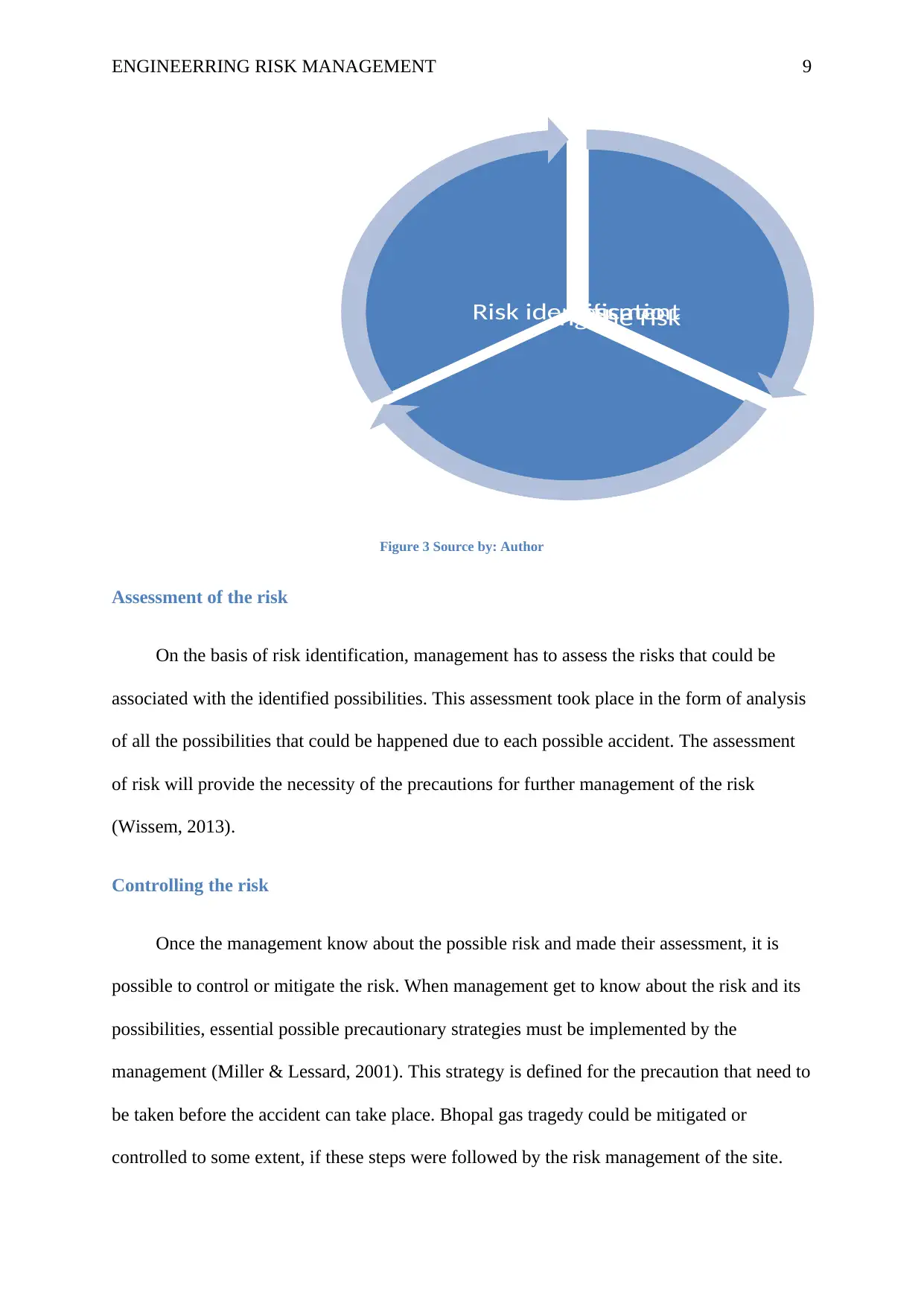
ENGINEERRING RISK MANAGEMENT 9
Figure 3 Source by: Author
Assessment of the risk
On the basis of risk identification, management has to assess the risks that could be
associated with the identified possibilities. This assessment took place in the form of analysis
of all the possibilities that could be happened due to each possible accident. The assessment
of risk will provide the necessity of the precautions for further management of the risk
(Wissem, 2013).
Controlling the risk
Once the management know about the possible risk and made their assessment, it is
possible to control or mitigate the risk. When management get to know about the risk and its
possibilities, essential possible precautionary strategies must be implemented by the
management (Miller & Lessard, 2001). This strategy is defined for the precaution that need to
be taken before the accident can take place. Bhopal gas tragedy could be mitigated or
controlled to some extent, if these steps were followed by the risk management of the site.
Risk assessmentControlling the riskRisk identificatio
Figure 3 Source by: Author
Assessment of the risk
On the basis of risk identification, management has to assess the risks that could be
associated with the identified possibilities. This assessment took place in the form of analysis
of all the possibilities that could be happened due to each possible accident. The assessment
of risk will provide the necessity of the precautions for further management of the risk
(Wissem, 2013).
Controlling the risk
Once the management know about the possible risk and made their assessment, it is
possible to control or mitigate the risk. When management get to know about the risk and its
possibilities, essential possible precautionary strategies must be implemented by the
management (Miller & Lessard, 2001). This strategy is defined for the precaution that need to
be taken before the accident can take place. Bhopal gas tragedy could be mitigated or
controlled to some extent, if these steps were followed by the risk management of the site.
Risk assessmentControlling the riskRisk identificatio
Paraphrase This Document
Need a fresh take? Get an instant paraphrase of this document with our AI Paraphraser
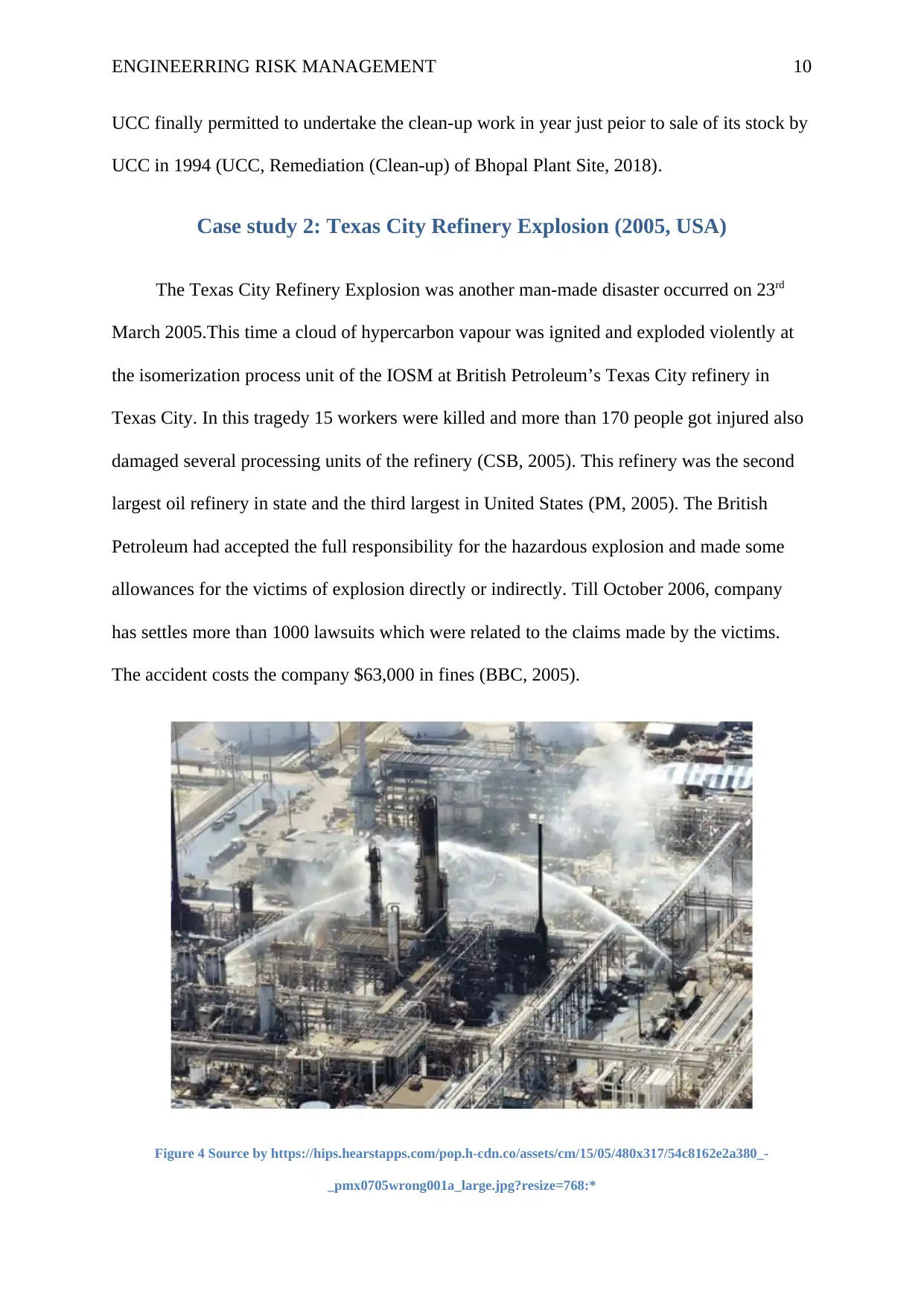
ENGINEERRING RISK MANAGEMENT 10
UCC finally permitted to undertake the clean-up work in year just peior to sale of its stock by
UCC in 1994 (UCC, Remediation (Clean-up) of Bhopal Plant Site, 2018).
Case study 2: Texas City Refinery Explosion (2005, USA)
The Texas City Refinery Explosion was another man-made disaster occurred on 23rd
March 2005.This time a cloud of hypercarbon vapour was ignited and exploded violently at
the isomerization process unit of the IOSM at British Petroleum’s Texas City refinery in
Texas City. In this tragedy 15 workers were killed and more than 170 people got injured also
damaged several processing units of the refinery (CSB, 2005). This refinery was the second
largest oil refinery in state and the third largest in United States (PM, 2005). The British
Petroleum had accepted the full responsibility for the hazardous explosion and made some
allowances for the victims of explosion directly or indirectly. Till October 2006, company
has settles more than 1000 lawsuits which were related to the claims made by the victims.
The accident costs the company $63,000 in fines (BBC, 2005).
Figure 4 Source by https://hips.hearstapps.com/pop.h-cdn.co/assets/cm/15/05/480x317/54c8162e2a380_-
_pmx0705wrong001a_large.jpg?resize=768:*
UCC finally permitted to undertake the clean-up work in year just peior to sale of its stock by
UCC in 1994 (UCC, Remediation (Clean-up) of Bhopal Plant Site, 2018).
Case study 2: Texas City Refinery Explosion (2005, USA)
The Texas City Refinery Explosion was another man-made disaster occurred on 23rd
March 2005.This time a cloud of hypercarbon vapour was ignited and exploded violently at
the isomerization process unit of the IOSM at British Petroleum’s Texas City refinery in
Texas City. In this tragedy 15 workers were killed and more than 170 people got injured also
damaged several processing units of the refinery (CSB, 2005). This refinery was the second
largest oil refinery in state and the third largest in United States (PM, 2005). The British
Petroleum had accepted the full responsibility for the hazardous explosion and made some
allowances for the victims of explosion directly or indirectly. Till October 2006, company
has settles more than 1000 lawsuits which were related to the claims made by the victims.
The accident costs the company $63,000 in fines (BBC, 2005).
Figure 4 Source by https://hips.hearstapps.com/pop.h-cdn.co/assets/cm/15/05/480x317/54c8162e2a380_-
_pmx0705wrong001a_large.jpg?resize=768:*
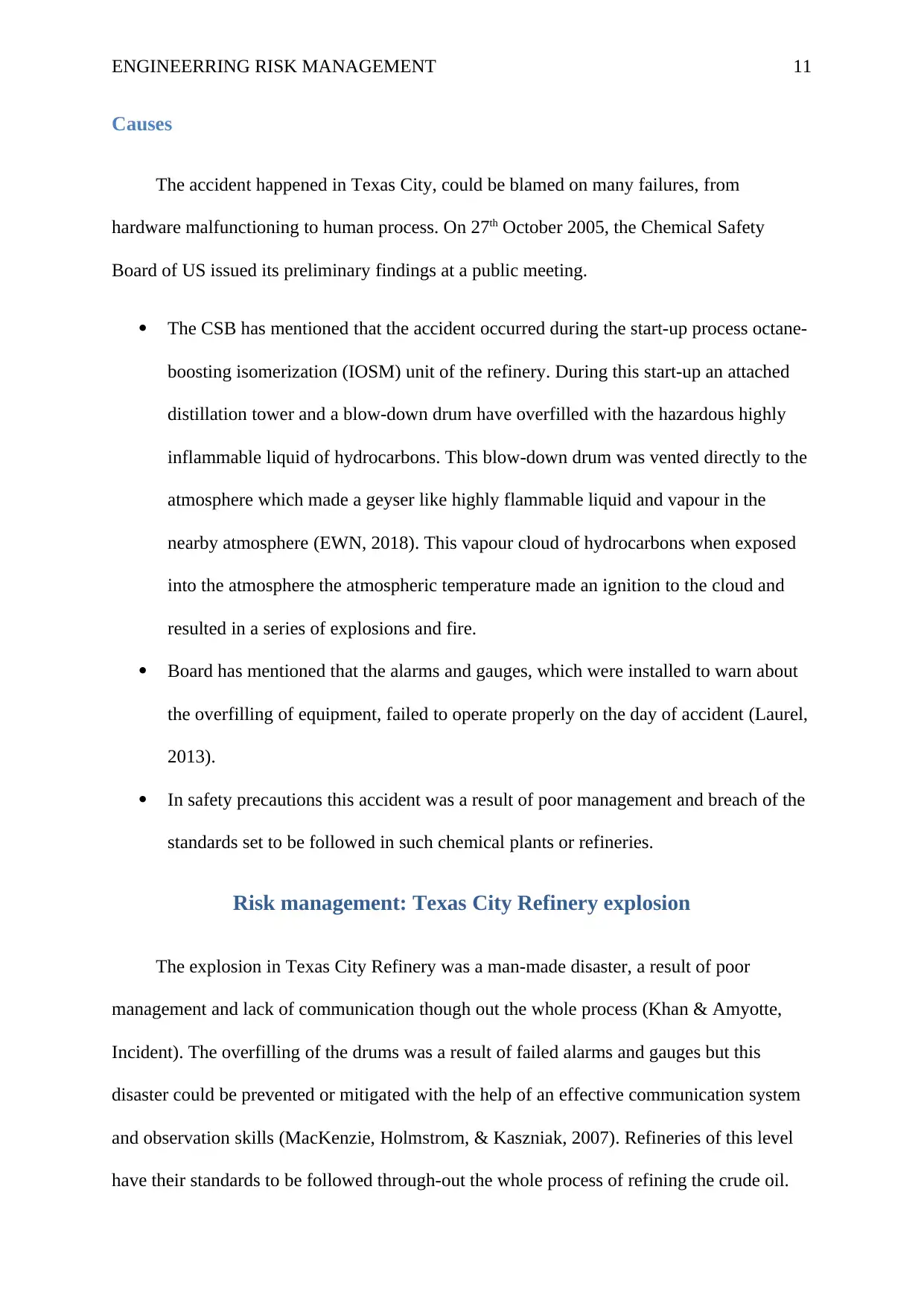
ENGINEERRING RISK MANAGEMENT 11
Causes
The accident happened in Texas City, could be blamed on many failures, from
hardware malfunctioning to human process. On 27th October 2005, the Chemical Safety
Board of US issued its preliminary findings at a public meeting.
The CSB has mentioned that the accident occurred during the start-up process octane-
boosting isomerization (IOSM) unit of the refinery. During this start-up an attached
distillation tower and a blow-down drum have overfilled with the hazardous highly
inflammable liquid of hydrocarbons. This blow-down drum was vented directly to the
atmosphere which made a geyser like highly flammable liquid and vapour in the
nearby atmosphere (EWN, 2018). This vapour cloud of hydrocarbons when exposed
into the atmosphere the atmospheric temperature made an ignition to the cloud and
resulted in a series of explosions and fire.
Board has mentioned that the alarms and gauges, which were installed to warn about
the overfilling of equipment, failed to operate properly on the day of accident (Laurel,
2013).
In safety precautions this accident was a result of poor management and breach of the
standards set to be followed in such chemical plants or refineries.
Risk management: Texas City Refinery explosion
The explosion in Texas City Refinery was a man-made disaster, a result of poor
management and lack of communication though out the whole process (Khan & Amyotte,
Incident). The overfilling of the drums was a result of failed alarms and gauges but this
disaster could be prevented or mitigated with the help of an effective communication system
and observation skills (MacKenzie, Holmstrom, & Kaszniak, 2007). Refineries of this level
have their standards to be followed through-out the whole process of refining the crude oil.
Causes
The accident happened in Texas City, could be blamed on many failures, from
hardware malfunctioning to human process. On 27th October 2005, the Chemical Safety
Board of US issued its preliminary findings at a public meeting.
The CSB has mentioned that the accident occurred during the start-up process octane-
boosting isomerization (IOSM) unit of the refinery. During this start-up an attached
distillation tower and a blow-down drum have overfilled with the hazardous highly
inflammable liquid of hydrocarbons. This blow-down drum was vented directly to the
atmosphere which made a geyser like highly flammable liquid and vapour in the
nearby atmosphere (EWN, 2018). This vapour cloud of hydrocarbons when exposed
into the atmosphere the atmospheric temperature made an ignition to the cloud and
resulted in a series of explosions and fire.
Board has mentioned that the alarms and gauges, which were installed to warn about
the overfilling of equipment, failed to operate properly on the day of accident (Laurel,
2013).
In safety precautions this accident was a result of poor management and breach of the
standards set to be followed in such chemical plants or refineries.
Risk management: Texas City Refinery explosion
The explosion in Texas City Refinery was a man-made disaster, a result of poor
management and lack of communication though out the whole process (Khan & Amyotte,
Incident). The overfilling of the drums was a result of failed alarms and gauges but this
disaster could be prevented or mitigated with the help of an effective communication system
and observation skills (MacKenzie, Holmstrom, & Kaszniak, 2007). Refineries of this level
have their standards to be followed through-out the whole process of refining the crude oil.
⊘ This is a preview!⊘
Do you want full access?
Subscribe today to unlock all pages.

Trusted by 1+ million students worldwide
1 out of 23
Related Documents
Your All-in-One AI-Powered Toolkit for Academic Success.
+13062052269
info@desklib.com
Available 24*7 on WhatsApp / Email
![[object Object]](/_next/static/media/star-bottom.7253800d.svg)
Unlock your academic potential
Copyright © 2020–2025 A2Z Services. All Rights Reserved. Developed and managed by ZUCOL.





